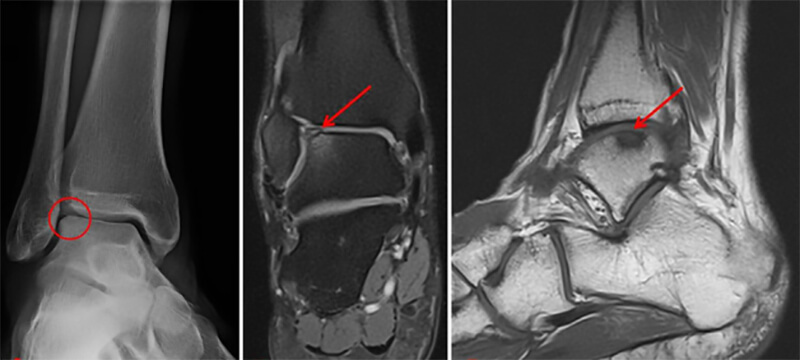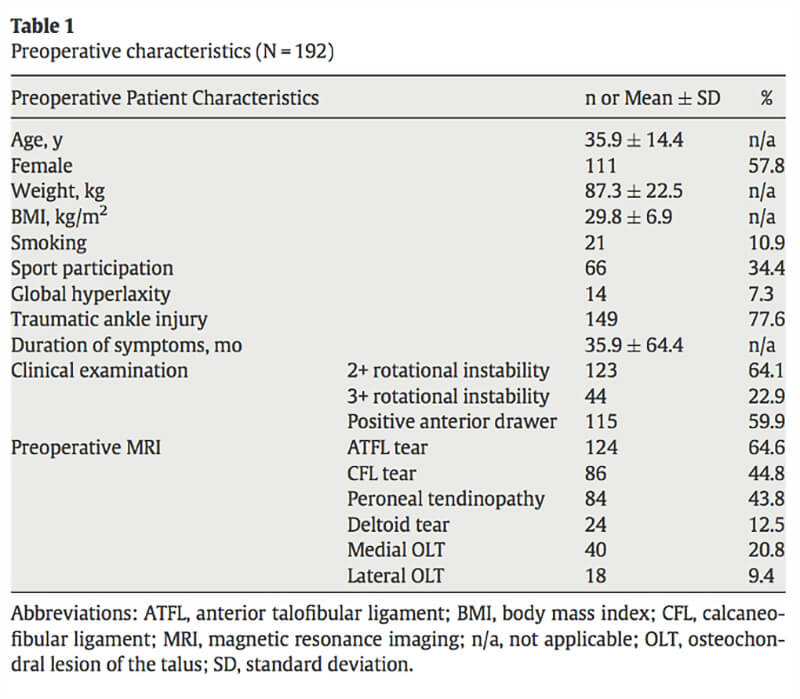Residency Insight
Predictors of Osteochondral Lesions of the Talus in Patients Undergoing Brostrom-Gould Ankle Ligament Reconstruction
Predictors of Osteochondral Lesions of the Talus in Patients Undergoing Brostrom-Gould Ankle Ligament Reconstruction

Reference
Design/Level
Level 3 Retrospective
Intro
Chronic ankle instability is rarely an isolated pathology, as studies have demonstrated that up to 95% of patients will have additional intra-articular or extra-articular pathology. In patients with osteochondral lesion of the talus (OLT), the identification of this condition is important, because it will likely change management and potentially the long-term outcomes.
Ankle instability has been broken down into categories of mechanical instability and functional instability, of which both may contribute to OLT formation. Regarding OLT formation, there are multiple possible causes, including trauma, vascular compromise, and metabolic, degenerative, or genetic causes. Another possible mechanism is repeated microtrauma, which may lead to cellular degeneration and death of chondral cells in the talus. A combination of these various etiologies may be present in the setting of chronic ankle instability, in which repeated sprains and prolonged altered joint biomechanics may prohibit healing of an initial articular insult and thus leads to the formation of an OLT.
A retrospective chart review was performed on patients who underwent a primary Brostrom-Gould lateral ankle ligament reconstruction for chronic ankle instability. This study evaluates various patient characteristics and evaluates the possible predictive value for a missed osteochondral lesion of the talus. This is the first study examining which patient characteristics other than ankle instability may predict OLT.

Goal
- The purpose of study is to review a cohort of patients who underwent Brostrom-Gould lateral ankle ligament reconstruction and investigate various clinical and imaging findings that may encourage the clinician to look more closely for an associated OLT.
- The study’s authors hypothesized that duration of ankle instability symptoms, concomitant peroneal tendon pathology, and athletic participation will be significant predictors of OLTs in patients with chronic ankle instability.
Patients/Methods
- A retrospective chart review was performed on 192 patients who underwent a primary Brostrom-Gould lateral ankle ligament reconstruction for chronic ankle instability from 2010 to 2014.
- Ankle stabilizing surgeries were completed by two foot and ankle specialists from 2010 to 2014 at a single institution. One of four fellowship trained musculoskeletal radiologists read all MRI studies and the primary surgeon verified reports.
- Indications for Brostrom-Gould surgery:
- Clinical instability (+anterior drawer and/or talar tilt test)
- Persistent symptoms despite conservative treatment
- Inclusion criteria:
- Patients who underwent a primary Brostrom-Gould lateral ankle ligament reconstruction
- Age range of 15 to 65 years
- Exclusion Criteria:
- Patients who underwent an ankle ligament reconstruction technique other than Brostrom-Gould
- Prior ankle surgery of any kind
- No pre-operative MRI was available for review
- Patients with and without a lesion were divided into two cohorts.
Results/Discussion

Preoperative findings, demographics, and magnetic resonance imaging findings are listed in Table 1.
Findings
- Fifty-three (27.6%) patients had one lesion identified on preoperative magnetic resonance imaging. Forty (69.0%) of these lesions were medial, 18 (31.0%) were lateral, and five patients had both.
- Sports participation was a positive predictor of a concomitant OLT.
- Female sex was a negative predictor of a concomitant lesion.
- Patients were less likely to have concomitant peroneal tendinopathy (30.2% vs 48.9%) in the presence of a lesion.
- The remainder of the variables (age, body mass index, smoking, trauma, duration, contralateral instability, global laxity) did not show a significant difference.
- Additionally, preoperative MRI demonstrated 124 (64.6%) ATFL tears, 86 (44.8%) CFL tears, and 24 (12.5%) deltoid ligament tears, and 84 (43.8%) patients had peroneal tendinopathy (including tears, subluxation).
- Age did not reveal a significant association with OLT in the present study. The average age of all patients from both cohorts was 35.9 +/- 14.5 years.
Limitations
A major weakness of this study is that it was likely underpowered to detect any additional associations than the two that were uncovered. There were not enough OLTs to determine if there were any different associations between a medial or lateral OLT, which is largely why they were grouped together. Additionally, all levels of athletic participation were grouped together to include recreational (9.2%), high school (6.9%), college (8.6%), semiprofessional (0.6%), and professional (0.6%) athletes. There were not enough athletes in each category to subdivide them into separate cohorts for analysis. Another weakness of the study is its retrospective design.
Conclusion
During the initial evaluation of patients with chronic ankle instability, recognizing the presence of concomitant pathology is extremely important. Chronic ankle instability is rarely an isolated pathology, as studies have demonstrated that up to 95% of patients will have additional intra-articular or extra-articular pathology. OLTs are present in as many as 63% of patients with ankle instability. Previous investigations have demonstrated poor clinical outcomes after undergoing ligament reconstruction for chronic ankle instability when an OLT is not addressed. There are many surgical options for treating these lesions, including fragment fixation, debridement and microfracture, osteoarticular autograft or allograft transfers, bone marrow derived cell implantation, and autologous chondrocyte implantation.
The current study reveals that female sex is a negative predictor for the presence of an OLT, and athletic participation is a positive predictor for the presence of an OLT. A strength of this study was demonstrating athletic participation as a positive predictor of OLTs in chronic ankle instability, which the study authors state, has not been established before this research.
Finally, this work also further confirms that in the setting of chronic ankle instability, peroneal tendinopathy was a negative predictor for the presence of an OLT. These findings will hopefully stimulate further research on this topic.
Relevance
This is the first study published which examines patient characteristics and pre-operative MRI findings that may be used to predict concomitant osteochondral lesions of the talus. Additionally, this is the first study examining which patient characteristics other than ankle instability may predict concomitant OLTs.
In patients with chronic lateral ankle instability, identifying patients with OLTs is important, because it will likely change management and possibly the long-term outcome of the patient.



Comments
There are 0 comments for this article